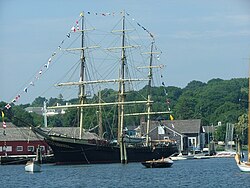Joseph Conrad (ship)
|
The Joseph Conrad at her berth in mysticism
|
||||||||||||||||||
|
||||||||||||||||||
|
||||||||||||||||||
|
||||||||||||||||||
|
||||||||||||||||||
The Joseph Conrad is a museum ship in Mystic Seaport . Originally she was built in 1882 as a sailing training ship for the Danish merchant fleet.
history
As Georg Stage
The ship was commissioned in 1882 by the Danish shipowner Carl Frederik Stage . It was a foundation ("Georg Stages Minde", Nyholm, Copenhagen) Stages and his wife Thea. The name Georg Stage was reminiscent of the Stages' only son, who died of tuberculosis in 1880 at the age of 22 . The aim of the foundation was to train the next generation of sailors in the Danish merchant fleet on the sailing training ship. The construction was carried out by the Burmeister & Wain shipyard in Refshaleøen, Copenhagen. In 1882 the sailor, rigged as one of the smallest full ships of its time, was put into operation with simple mars and brambles as well as royals (four yards per mast). A simple auxiliary steam engine with around 50 hp was also installed on board in order to be able to give the youngsters an insight into this area of ship technology. The Georg Stage carried out six-month training trips in the North and Baltic Seas with a permanent crew of around ten seamen and around 80 candidate officers from the merchant fleet.
In 1905 the ship was sunk in a collision with the steamer Ancona of Leith near the middle ground sandbank (a shoal in the middle of the fairway) in the Öresund , 22 young sailors were killed. The ship was lifted, repaired and made safer by installing bulkheads. The steam engine was replaced in 1915 by an auxiliary diesel with 60 hp. In 1934 the ship was replaced by its successor of the same name because it had become too small for the training program. During his service, more than 4,000 cadets were trained on the first Georg Stage .
As Joseph Conrad
Although there were plans to scrap the 52-year-old ship, the Australian naval author and captain Alan Villiers (1903-1982) was a sailing enthusiast buyer. Villiers renamed the ship Joseph Conrad after the famous British captain and naval author and traveled around 58,000 nautical miles with her over the next two years. Again young seafarers were trained. Villiers processed these trips in the three books The Cruise of the "Conrad" (1937), Stormalong (1937) and Joey Goes To Sea (1939).
In 1936, George Huntington Hartford bought the Conrad , had a new engine installed and used the ship as a private yacht until 1939. Under Hartford's aegis, the ship won both the outward and return rounds of a square sail race from the United States to Bermuda against the Seven Seas . When the Second World War broke out, Hartford passed the Joseph Conrad on to the United States Maritime Commission , which continued to use the ship to train cadets until 1945. The ship lay in place until 1947 before it was transferred to the Mystic Seaport by the US Congress.
literature
- Schäuffelen, Otmar: The last great sailing ships . Delius Klasing publishing house, Bielefeld 1994, ISBN 3-7688-0860-2 .
Web links
- Museum page of Joseph Conrad (English)
